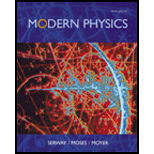
Concept explainers
(a)
Verify the equation for the magnitude of electric field.
(a)
Answer to Problem 1P
It is proved that the magnitude of electric field is given by
Explanation of Solution
Write the given equation for the relation between electric field and magnetic flux.
Here,
Write the equation for the magnetic flux.
Here,
Conclusion:
Substitute equation (II) in equation (I) and also substitute
Therefore, it is proved that the magnitude of electric field is given by
(b)
The change in speed of electron.
(b)
Answer to Problem 1P
The change in speed of the electron is
Explanation of Solution
Write the equation for the force acting on the electron.
Here,
Write the equation for the force acting on the electron in term of the acceleration of electron.
Here,
Substitute equation (III) in equation (IV) and compare it with equation (V).
Conclusion:
Integrate equation (VI) by giving appropriate limits.
Therefore, the change in speed is
(c)
The fractional change in frequency.
(c)
Answer to Problem 1P
The fractional change in frequency is
Explanation of Solution
Write the equation for the change in frequency of electron.
Here,
Substitute equation (VII) in equation (VIII).
Write the equation for the frequency of electron.
Here,
Conclusion:
Substitute
Substitute
Find the ratio
Therefore, the fractional change in frequency is
(d)
The explanation for lines at
(d)
Answer to Problem 1P
The
Explanation of Solution
The plane of electrons is parallel to
The
The
Conclusion:
Therefore, the
Want to see more full solutions like this?
Chapter 3 Solutions
Modern Physics
- Suppose that we do not know quantum mechanics and that the electron of a hydrogen atom behaves like a harmonic oscillator with a certain oscillation frequency f. In this model, an excited electron can therefore emit light and this has the same frequency f as the oscillating motion of the electron.It is observed that the light emitted by such an atom has a frequency of 800 Hz and the oscillating movement of the electron has an amplitude of 0,418 nm. In electro-volts, what is its mechanical energy?arrow_forwardGiven a photon with a wavelength of 520 nm, find the energy and momentum of the photon. What equivalent mass would a particle have if all the energy of the photon were converted to mass? *I ask that the answer be written with clear and readable handwriting or typed*arrow_forwardWhat is the de Broglie wavelength of(a) a bullet of mass 0.040 kg travelling at the speed of 1.0 km/s,(b) a ball of mass 0.060 kg moving at a speed of 1.0 m/s, and(c) a dust particle of mass 1.0 × 10-9 kg drifting with a speed of 2.2 m/s?arrow_forward
- What are (a) the energy of a photon corresponding to wavelength 1.00 nm, (b) the kinetic energy of an electron with de Broglie wavelength 1.00 nm, (c) the energy of a photon corresponding to wavelength 1.00 fm, and (d) the kinetic energy of an electron with de Broglie wavelength 1.00 fm?arrow_forwardIn a beam of white light (wavelengths from 400 to 750 nm), what range of momentum can the photons have?arrow_forwardWhat is the de Brogue wavelength of an electron travelling at a speed of 5.0106 m/s ?arrow_forward
 Modern PhysicsPhysicsISBN:9781111794378Author:Raymond A. Serway, Clement J. Moses, Curt A. MoyerPublisher:Cengage Learning
Modern PhysicsPhysicsISBN:9781111794378Author:Raymond A. Serway, Clement J. Moses, Curt A. MoyerPublisher:Cengage Learning Physics for Scientists and Engineers with Modern ...PhysicsISBN:9781337553292Author:Raymond A. Serway, John W. JewettPublisher:Cengage Learning
Physics for Scientists and Engineers with Modern ...PhysicsISBN:9781337553292Author:Raymond A. Serway, John W. JewettPublisher:Cengage Learning Principles of Physics: A Calculus-Based TextPhysicsISBN:9781133104261Author:Raymond A. Serway, John W. JewettPublisher:Cengage Learning
Principles of Physics: A Calculus-Based TextPhysicsISBN:9781133104261Author:Raymond A. Serway, John W. JewettPublisher:Cengage Learning University Physics Volume 3PhysicsISBN:9781938168185Author:William Moebs, Jeff SannyPublisher:OpenStax
University Physics Volume 3PhysicsISBN:9781938168185Author:William Moebs, Jeff SannyPublisher:OpenStax Glencoe Physics: Principles and Problems, Student...PhysicsISBN:9780078807213Author:Paul W. ZitzewitzPublisher:Glencoe/McGraw-Hill
Glencoe Physics: Principles and Problems, Student...PhysicsISBN:9780078807213Author:Paul W. ZitzewitzPublisher:Glencoe/McGraw-Hill




